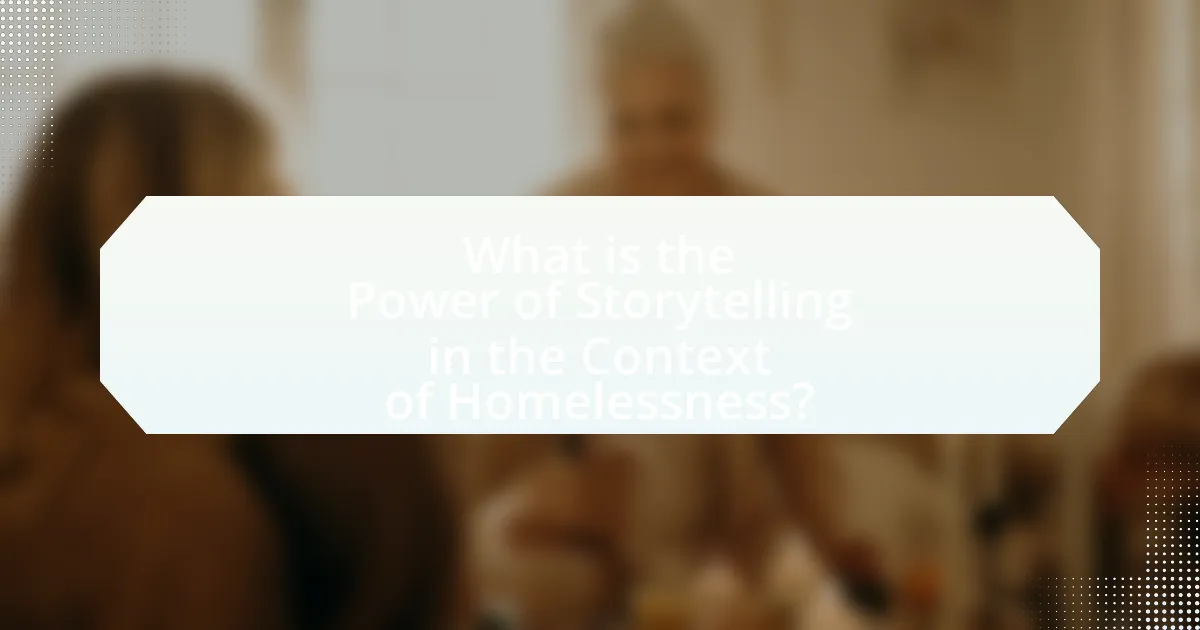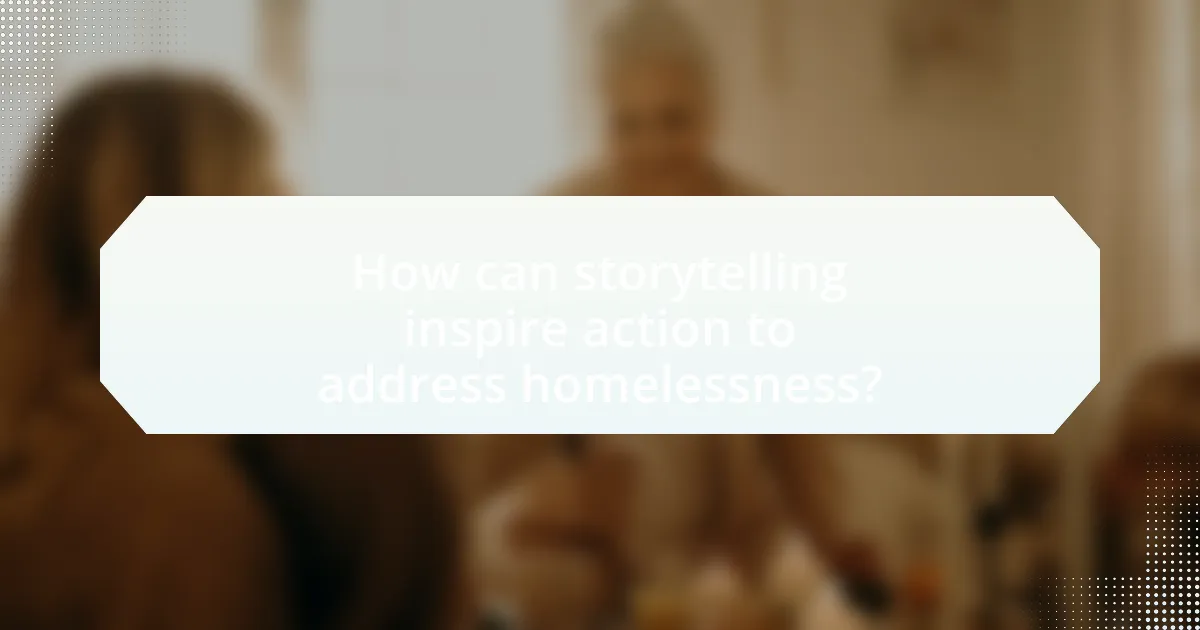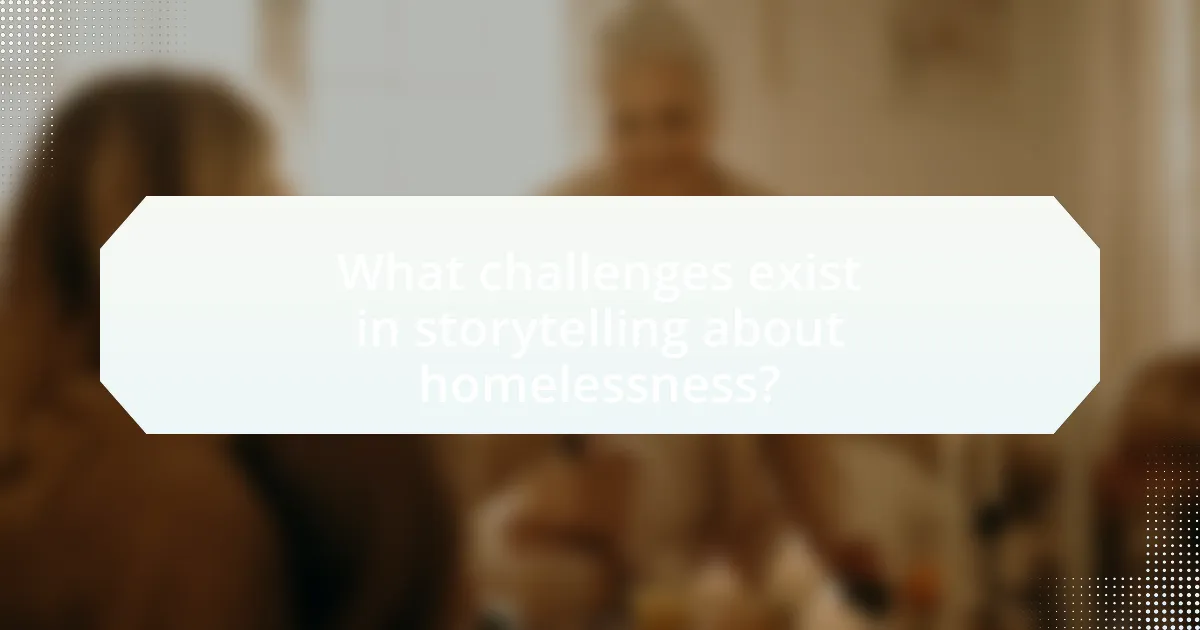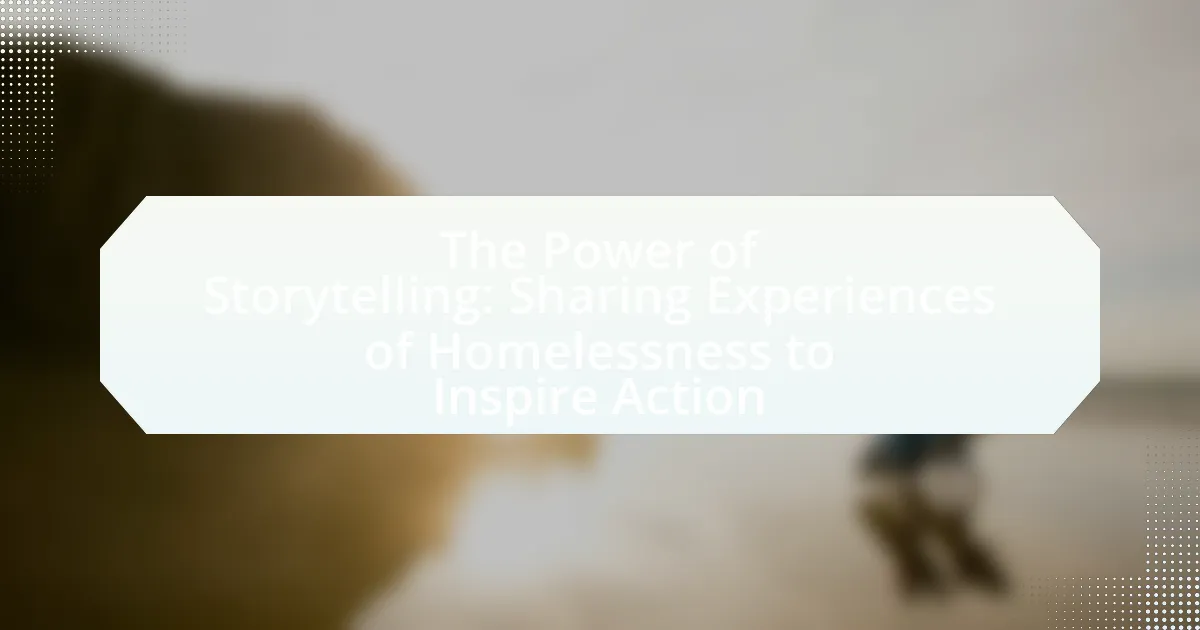The article explores the significant role of storytelling in addressing homelessness, emphasizing its ability to humanize the issue and foster empathy among audiences. It discusses how personal narratives can influence public perception, challenge stereotypes, and inspire action, ultimately driving systemic change. Key topics include the emotional connections created through storytelling, the impact of vulnerability, and the importance of ethical considerations in representing the experiences of homeless individuals. Additionally, the article highlights effective methods for sharing stories, the challenges faced by storytellers, and the resources available for those looking to engage in storytelling initiatives focused on homelessness.

What is the Power of Storytelling in the Context of Homelessness?
The power of storytelling in the context of homelessness lies in its ability to humanize the issue and foster empathy among audiences. By sharing personal narratives, individuals experiencing homelessness can convey their struggles, hopes, and resilience, which statistics alone cannot achieve. Research indicates that storytelling can significantly influence public perception and policy decisions; for instance, a study published in the Journal of Social Issues found that narratives about homelessness increased compassion and willingness to support social programs. This emotional connection can lead to greater advocacy and action, ultimately driving systemic change to address homelessness effectively.
How does storytelling influence perceptions of homelessness?
Storytelling significantly influences perceptions of homelessness by humanizing individuals experiencing it and fostering empathy among audiences. When narratives focus on personal experiences, they challenge stereotypes and misconceptions, allowing listeners to see the complexities of homelessness beyond statistics. Research indicates that stories can evoke emotional responses, which are more impactful than mere facts; for instance, a study published in the journal “Social Science & Medicine” found that narratives about homelessness led to increased compassion and willingness to help among participants. By sharing authentic experiences, storytelling not only raises awareness but also encourages societal engagement and action towards addressing homelessness.
What emotional connections can stories create for audiences?
Stories can create deep emotional connections for audiences by evoking empathy, compassion, and understanding. When narratives depict the struggles and triumphs of individuals, particularly in contexts like homelessness, they allow audiences to relate personally to the experiences shared. Research indicates that storytelling activates the brain’s mirror neurons, which facilitate emotional resonance and empathy, making listeners feel as if they are experiencing the events themselves. For instance, a study published in the journal “Psychological Science” by Paul Zak found that stories can increase oxytocin levels, a hormone associated with bonding and empathy, thereby enhancing emotional connections. This mechanism is particularly powerful in storytelling about homelessness, as it can inspire action and foster a sense of community responsibility.
How do personal narratives change societal attitudes towards homelessness?
Personal narratives significantly change societal attitudes towards homelessness by humanizing the issue and fostering empathy. When individuals share their personal experiences of homelessness, they provide relatable stories that challenge stereotypes and misconceptions, making the plight of homeless individuals more tangible. Research indicates that storytelling can reduce stigma; for instance, a study published in the Journal of Social Issues found that narratives about homelessness led to increased compassion and support for policy changes among listeners. By presenting real-life accounts, personal narratives encourage audiences to see homeless individuals as complex human beings rather than statistics, ultimately promoting a more compassionate societal perspective.
Why is sharing experiences of homelessness important?
Sharing experiences of homelessness is important because it humanizes the issue and fosters empathy among the public. When individuals share their stories, they provide personal insights into the challenges and realities of homelessness, which statistics alone cannot convey. Research indicates that narratives can significantly influence public perception and policy decisions; for instance, a study by the Urban Institute found that storytelling can increase support for social programs aimed at addressing homelessness. By sharing these experiences, individuals can inspire action, raise awareness, and encourage community engagement to combat homelessness effectively.
What role does vulnerability play in storytelling?
Vulnerability plays a crucial role in storytelling by fostering emotional connection and authenticity between the storyteller and the audience. When individuals share their personal struggles, such as experiences of homelessness, they invite empathy and understanding, which can inspire action and change. Research indicates that narratives highlighting vulnerability can significantly impact listeners’ attitudes and behaviors, as they often resonate on a deeper emotional level, making the stories more relatable and compelling. For instance, studies have shown that stories that include elements of vulnerability can increase audience engagement and motivate them to support social causes, such as homelessness initiatives.
How can shared experiences foster empathy and understanding?
Shared experiences foster empathy and understanding by allowing individuals to connect on a personal level, bridging emotional and cognitive gaps. When people share stories, particularly those related to challenging situations like homelessness, they humanize abstract concepts, making them relatable. Research indicates that narratives can activate emotional responses in listeners, leading to increased empathy. For instance, a study published in the journal “Emotion” by Paul Zak found that storytelling can enhance feelings of empathy and compassion by triggering the release of oxytocin, a hormone associated with bonding. This biological response reinforces the idea that shared experiences can create a deeper understanding of others’ struggles and perspectives.

How can storytelling inspire action to address homelessness?
Storytelling can inspire action to address homelessness by humanizing the issue and fostering empathy among audiences. When individuals hear personal narratives from those experiencing homelessness, they are more likely to connect emotionally, which can lead to increased awareness and motivation to take action. Research indicates that stories evoke emotional responses that can drive behavioral change; for instance, a study published in the journal “Psychological Science” found that narratives can significantly influence attitudes and intentions. By sharing real-life experiences, storytelling not only highlights the complexities of homelessness but also encourages community engagement and support for solutions, such as advocacy for policy changes or increased funding for shelters and services.
What methods can be used to share stories effectively?
Effective methods to share stories include using personal narratives, visual storytelling, and digital platforms. Personal narratives engage audiences by providing authentic experiences that evoke empathy; for instance, individuals sharing their own experiences of homelessness can create a powerful emotional connection. Visual storytelling, such as photographs or videos, enhances the narrative by providing a visual context that can be more impactful than words alone. Digital platforms, including social media and blogs, allow for broader dissemination of stories, reaching diverse audiences and encouraging community engagement. Research indicates that storytelling can significantly influence public perception and inspire action, as evidenced by campaigns that have successfully raised awareness about homelessness through shared personal stories.
How do different mediums (e.g., written, visual, oral) impact storytelling?
Different mediums, such as written, visual, and oral, significantly impact storytelling by influencing how narratives are perceived and understood. Written storytelling allows for in-depth exploration of characters and themes, providing detailed context and emotional depth, as seen in novels that delve into the complexities of homelessness. Visual storytelling, through images or videos, evokes immediate emotional responses and can convey powerful messages quickly, as demonstrated by documentaries that highlight the struggles of homeless individuals. Oral storytelling fosters personal connection and engagement, allowing for real-time interaction and emotional resonance, which is often utilized in community discussions about homelessness. Each medium shapes the audience’s experience and understanding of the story, making the choice of medium crucial in effectively conveying messages and inspiring action.
What are the best practices for crafting compelling narratives?
The best practices for crafting compelling narratives include establishing a clear structure, engaging the audience emotionally, and using vivid imagery. A clear structure, typically consisting of a beginning, middle, and end, helps guide the audience through the story, making it easier to follow and understand. Engaging the audience emotionally is crucial; research shows that stories that evoke emotions can lead to greater empathy and connection, which is particularly important when discussing sensitive topics like homelessness. Vivid imagery enhances the narrative by painting a picture in the audience’s mind, making the experiences more relatable and impactful. For instance, a study by Paul Zak in 2013 found that narratives that include emotional elements can increase oxytocin levels, fostering empathy and encouraging action.
Why should organizations utilize storytelling in their advocacy efforts?
Organizations should utilize storytelling in their advocacy efforts because it effectively humanizes issues and fosters emotional connections with audiences. Storytelling allows organizations to present complex social issues, such as homelessness, in relatable and compelling narratives that resonate with individuals on a personal level. Research indicates that narratives can increase empathy and understanding, making audiences more likely to engage and take action. For instance, a study published in the journal “Psychological Science” found that stories can significantly enhance the persuasiveness of messages, leading to increased support for advocacy initiatives. By sharing personal experiences of homelessness, organizations can inspire action and mobilize community support, ultimately driving change.
How can storytelling enhance fundraising and support initiatives?
Storytelling enhances fundraising and support initiatives by creating emotional connections that motivate donors to contribute. When organizations share personal narratives of individuals affected by homelessness, they humanize the issue, making it relatable and urgent. Research indicates that emotional appeals can increase donations; for instance, a study published in the Journal of Marketing Research found that stories can lead to a 20% increase in charitable giving compared to statistics alone. By illustrating the impact of donations through compelling stories, organizations can effectively engage potential supporters and drive action.
What examples exist of successful storytelling campaigns in homelessness advocacy?
Successful storytelling campaigns in homelessness advocacy include “Humans of New York,” which shares personal narratives of individuals experiencing homelessness, fostering empathy and understanding. This campaign has garnered millions of views and raised significant funds for various homeless initiatives, demonstrating the impact of personal stories on public perception and support. Another example is “The Homeless World Cup,” which uses the power of soccer to tell the stories of homeless individuals, showcasing their resilience and inspiring action through sports. This initiative has successfully engaged communities and raised awareness about homelessness globally.

What challenges exist in storytelling about homelessness?
Storytelling about homelessness faces several challenges, including stigma, oversimplification, and lack of representation. Stigma surrounding homelessness often leads to negative stereotypes, which can distort narratives and perpetuate misconceptions. Oversimplification occurs when complex issues are reduced to single stories, failing to capture the diverse experiences of individuals facing homelessness. Additionally, lack of representation in storytelling can result in narratives that do not accurately reflect the voices and experiences of those affected, further marginalizing their stories. These challenges hinder the effectiveness of storytelling as a tool for inspiring action and fostering understanding.
How can ethical considerations impact storytelling practices?
Ethical considerations significantly impact storytelling practices by guiding the representation of marginalized voices, ensuring accuracy, and fostering empathy. In the context of homelessness, ethical storytelling requires sensitivity to the lived experiences of individuals, avoiding stereotypes and exploitation. For instance, the National Coalition for the Homeless emphasizes the importance of portraying homeless individuals with dignity and respect, which can influence public perception and policy. By adhering to ethical standards, storytellers can create narratives that not only inform but also inspire action and promote social justice.
What are the risks of misrepresentation in storytelling?
Misrepresentation in storytelling poses significant risks, particularly in the context of sharing experiences of homelessness. It can lead to the perpetuation of stereotypes, which may further marginalize already vulnerable populations. For instance, inaccurate portrayals can reinforce negative perceptions of homeless individuals, suggesting they are solely responsible for their circumstances, rather than highlighting systemic issues such as lack of affordable housing or mental health support. Additionally, misrepresentation can distort public understanding and policy responses, resulting in ineffective or harmful interventions. Research indicates that narratives that fail to accurately represent the complexities of homelessness can diminish empathy and reduce the likelihood of community support for effective solutions.
How can storytellers ensure authenticity and respect for subjects?
Storytellers can ensure authenticity and respect for subjects by engaging in thorough research and fostering open dialogue with the individuals whose stories they aim to tell. This approach allows storytellers to accurately represent the lived experiences of their subjects, particularly in sensitive contexts such as homelessness. For instance, involving subjects in the storytelling process not only validates their perspectives but also empowers them, as seen in initiatives like the “Homeless Voices” project, which highlights narratives directly from individuals experiencing homelessness. By prioritizing consent and collaboration, storytellers can create narratives that honor the dignity and complexity of their subjects, ultimately leading to more impactful and respectful storytelling.
What barriers do storytellers face when sharing experiences of homelessness?
Storytellers face several barriers when sharing experiences of homelessness, including stigma, lack of trust, and limited access to platforms. Stigma surrounding homelessness often leads to negative perceptions, making it difficult for storytellers to be heard or taken seriously. Additionally, individuals experiencing homelessness may struggle to establish trust with audiences or organizations, which can hinder their willingness to share personal narratives. Limited access to platforms for storytelling, whether due to financial constraints or lack of media representation, further restricts their ability to reach wider audiences. These barriers collectively impede the effective sharing of experiences that could inspire action and foster understanding.
How can stigma affect the willingness to share personal stories?
Stigma significantly reduces the willingness to share personal stories, particularly among individuals experiencing homelessness. This reduction occurs because stigma creates fear of judgment, discrimination, and social isolation, leading individuals to feel vulnerable and unsafe when disclosing their experiences. Research indicates that 70% of people experiencing homelessness report feeling stigmatized, which directly correlates with their reluctance to share their narratives. The fear of negative repercussions, such as being labeled or marginalized, further discourages open communication about their struggles, thereby hindering the potential for empathy and understanding from the broader community.
What support systems are necessary for effective storytelling?
Effective storytelling requires a combination of emotional support, community engagement, and access to resources. Emotional support helps storytellers process their experiences and convey authenticity, while community engagement fosters connections that amplify their narratives. Access to resources, such as training in storytelling techniques and platforms for sharing stories, enhances the impact of their messages. Research indicates that storytelling initiatives, particularly in contexts like homelessness, can lead to increased empathy and action among audiences, demonstrating the importance of these support systems in creating meaningful narratives.
What practical steps can individuals take to share stories of homelessness?
Individuals can share stories of homelessness by utilizing various platforms such as social media, community events, and local media outlets. Social media allows for wide dissemination of personal narratives, enabling individuals to reach a larger audience and foster empathy. Community events, such as open mic nights or storytelling workshops, provide a space for individuals experiencing homelessness to share their stories directly, creating personal connections. Additionally, collaborating with local newspapers or radio stations can amplify these stories, raising awareness and prompting community discussions. Research indicates that storytelling can significantly influence public perception and policy regarding homelessness, highlighting the importance of personal narratives in inspiring action.
How can community members get involved in storytelling initiatives?
Community members can get involved in storytelling initiatives by participating in local workshops, sharing their personal experiences, and collaborating with organizations focused on homelessness. These initiatives often seek diverse voices to highlight the complexities of homelessness, and community members can contribute by attending events, volunteering their time, or providing resources for storytelling projects. For example, organizations like StoryCorps have successfully engaged communities in sharing narratives that foster understanding and empathy, demonstrating the impact of collective storytelling in addressing social issues.
What resources are available for aspiring storytellers focused on homelessness?
Aspiring storytellers focused on homelessness can access various resources, including workshops, online courses, and community organizations dedicated to this subject. Organizations like the National Coalition for the Homeless provide educational materials and storytelling workshops that help individuals learn how to effectively share experiences related to homelessness. Additionally, platforms such as StoryCorps offer resources for recording and sharing personal narratives, emphasizing the importance of storytelling in raising awareness about homelessness. Furthermore, online platforms like Coursera and Udemy feature courses on narrative writing and documentary storytelling, which can enhance the skills of those interested in this topic. These resources collectively support aspiring storytellers in crafting impactful narratives that inspire action and foster understanding of homelessness.

Leave a Reply